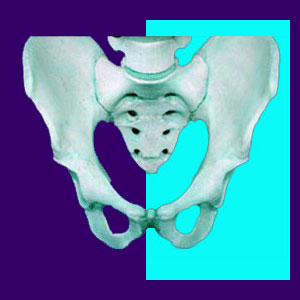
Chiropractic for sacroiliac joint pain targets one of the common conditions treated with manual skeletal adjustments and provides a conservative treatment option for patients who have been diagnosed with any of the variety of SI joint concerns.
The sacroiliac joint is commonly implicated in lower back pain and sciatica syndromes by chiropractors far more than diagnosed by physicians. It is crucial to understand the facts about the SI joint before undergoing any long-term care for a diagnosed pain syndrome. Remember, the SI joint will suffer some degree of degeneration as part of its normal lifespan. However, the joint is also one of the strongest and best designed in the entire anatomy, making many diagnoses of sacroiliac pain seem quite baseless.
Chiropractic for SIJ Pain Facts
The SI joint is incredibly powerful and resistant to injury. When stressed, this joint is so strong that the pelvis will break prior to damage being done inside the joint itself.
Pain due to SI joint problems is almost always diagnosed as being caused by ligament issues, typically called sacroiliac joint dysfunction, or by arthritic issues, diagnosed as sacroiliitis.
Ligaments are diagnosed as being too tight or too loose in practically equal numbers, and this diagnostic theory is often incorrect. In cases of ligament involvement, the true process causing the pain may be regional ischemia of the ligaments and surrounding soft tissues and nerves.
For arthritic concerns, the presence of degenerative changes in the SI joint is normal and expected and most cases are not problematic. However, in very, very rare cases, severe and abnormal structural changes may actually be responsible for the pain and may require drastic or even surgical treatment.
In these extreme cases, chiropractic is unlikely to provide much benefit, since the source of pain exists inside the joint and will not respond to manipulation in most patients.
Chiropractic for Sacroiliac Joint Pain Treatment
Chiropractors treat SI joint concerns with typical and specialized spinal adjustments. Often times, these chiropractic adjustments may bring relief, although the reasoning behind them is not exactly clear. If the ligament is implicated, adjusting the bones is unlikely to do a thing, while if arthritis is involved, an adjustment may help facilitate functionality, but is not likely to bring pain alleviation. In fact, an adjustment may cause exacerbated pain in cases of sacroiliitis. Remember, these scenarios involve bone on bone contact, osteophyte formation and arthritic debris inside the joint which typically become more symptomatic upon movement. Forcing the joint to move is likely to cause pain, not provide relief.
The placebo effect may be wholly or partially responsible for relief provided when the diagnostic theory is not correct, which is no surprise, since many patients enjoy this benefit from chiropractic. Remember, if treatment is not targeting the source of pain, or not providing any actual efficacy, then any relief provided is likely to be due to placebo.
Do not be discouraged by this article if chiropractic is working well for you, regardless of your diagnosis. Chiropractic for sacroiliac joint pain is holistic and natural, meaning it is always a far preferred path to surgery or pharmaceutical pain management. If you feel good with chiropractic, then stick with it!
Chiropractic for Sacroiliac Joint Pain Opinions
In my many years of helping patients with their back pain and sciatica, I have seen the incidence of sacroiliac pain diagnoses increase many fold. This is easily explained, since the usual suspect spinal abnormalities formerly blamed for sourcing agony are becoming better known to be innocent and asymptomatic.
Therefore, care providers need new diagnostic scapegoats to keep that all important money flowing. In many cases I have personally come across (1000s, literally), the diagnosis of SI joint pain was completely wrong. In some of these instances, the pain was due to another structural source. In other cases, the symptoms were ischemic and often not even affecting the actual area in which the joint is located.
My advice is as usual: If your SI pain has not resolved despite a range of therapy options, give yourself a push in the right direction and reconsider the validity of the causative theory.
In the meantime, start the ball rolling by asking your chiropractor to explain in detail exactly what they feel is wrong with your SI joint and how their treatment will correct it. Take the information they provide and research it further. In fact, talk to your physician about it, as well. If something seems to be “not right”, then maybe consider getting an opinion from a new chiropractor.
Back Pain > Chiropractor > Chiropractic for Sacroiliac Joint Pain





